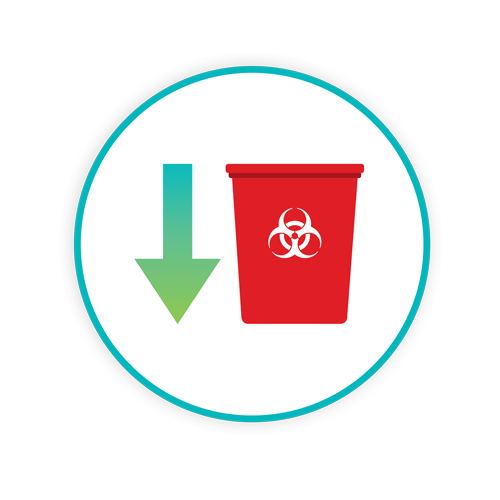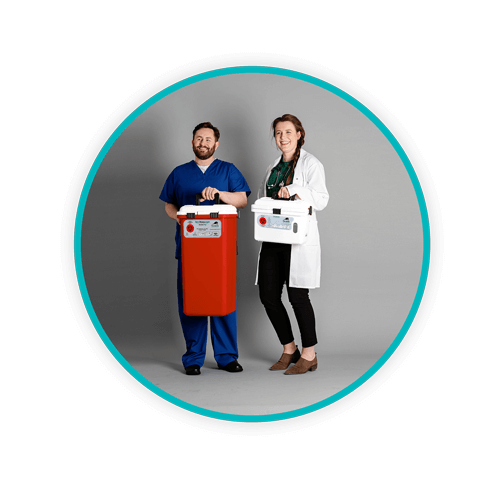The Impact Of COVID on Regulated Medical Waste Volumes

America prepared for an onslaught of regulated medical waste when COVID first appeared in the U. S. But the amount added to RMW streams by COVID was less than the amount subtracted by the suspension of elective surgeries. So the total amount of RMW actually declined—thanks to appropriate identification, collection, and separation protocols.
TOPICS WE WILL COVER
1 / Introduction to COVID Medical Waste
2 / Most COVID Waste isn’t Regulated Medical Waste
3 / The Onslaught that Hasn’t Happened
5 / Implications of Improper COVID Waste Segregation
Introduction to COVID Medical Waste
During the course of the COVID pandemic, it’s estimated that hospital waste generation in the U.S. increased from 5-million tons per year to 2.5 million tons per month. In other words, from 5‑million to 30‑million tons in a single year: a six-fold increase, aka 600 percent.
 Yet, the level of regulated medical waste (RMW) has actually declined. How can this be?
Yet, the level of regulated medical waste (RMW) has actually declined. How can this be?
- Consider that as of April 2021, more than 390 million COVID tests have been given, generating a concomitant number of swabs—not to mention their packaging.
- Added to that, since December 2020, more than 167 million COVID vaccine doses have been administered in the U.S, each requiring disposal for a vial, needle and syringe.
- Another constituent of ballooning hospital waste is single-use plastics, much of which is used for personal protection equipment (PPE) such as gloves and masks.
Exacerbating matters, because PPE is the most reliable and cost-effective defense against COVID infection & transmission, the amount of hospital waste generated across the country’s 6000+ hospitals isn’t expected to decline as the pandemic abates, but instead increase by as much as 20 percent by the year 2025—which would be 36-million tons yearly.
So what’s the explanation for decreased RMW?
Most COVID Waste isn’t Regulated Medical Waste
First and foremost, it’s important to distinguish regulated medical waste from what’s commonly called “hospital waste” or sometimes “healthcare waste.”
The World Health Organization (WHO) estimates that 85 percent of hospital waste is of the general nonhazardous variety. More than half of this is paper & cardboard (54%), the remainder being organics (18%), plastics (15%), metal (3%), glass (2%), and unspecified (8%).
To date, WHO guidance has been that such non-hazardous wastes from COVID patients can be processed through regular procedures, and don’t require any special handling, which means that only 15 percent of COVID waste is properly considered RMW.
The Onslaught that Hasn’t Happened
When COVID first appeared in the U.S., the American waste management industry prepared for an onslaught of RMW, similar to what the world was witnessing in Wuhan. But it didn’t happen.
Instead, RMW volumes (considered separately from general hospital waste) actually declined from pre-pandemic levels. This seemingly incongruous result can be attributed to two factors:
- First was the suspension of most elective procedures during the worst days of the pandemic. As these surgeries weren’t happening, they weren’t adding to RMW streams.
- Less obvious, the robust sorting & handling protocols already common to U.S. hospitals helped them avoid spurious diversions of nonhazardous COVID wastes into RMW streams and needlessly swelling those volumes.
In other words, the amount added to RMW streams by COVID was less than the amount subtracted by the suspension of elective surgeries—thanks to careful identification & segregation of wastes. So the total amount of RMW actually declined.
Beware of Bad Advice
Various authorities have suggested that all waste generated within a healthcare facility should be treated as RMW if that facility is treating COVID patients, which would greatly inflate the need for RMW disposal procedures.
But according to CDC guidance, regulated medical waste from healthcare facilities doesn’t differ from any other kind of regulated medical waste, and thereby should be processed following routine RMW disposal procedures.
Implications Of Improper COVID Waste Segregation
The way in which waste streams were and continue to be affected by COVID highlights the importance of differentiating RMW from what’s merely “hospital waste” or “healthcare waste.”
In-service training is crucial to ensure that all staff understand that not all hospital waste is RCRA hazardous waste or RMW, and so most of what they need to dispose of doesn’t belong in the RMW stream—as much as 85 percent of it per the WHO.
The second step is ensuring that your protocols concerning waste identification, collection, and separation, are clear and easy-to-use so that employees are disposing of COVID-19 waste safely without treating something as RMW when it isn’t.
The Upshot
Regulated medical waste disposal has become an important tactic in the battle against COVID, requiring appropriate identification, collection, separation, storage, transportation, treatment, and disposal. Fortunately, the U.S. has the resources to meet this challenge.
Consider, at the onset of COVID, China’s authoritarian government was at first ill-equipped to deal with its challenges, having only ad hoc regulations and inadequate resources; and its response was hindered by a national transportation lockdown. In contrast, the U.S. could turn to its private, well-established, highly-regulated medical-waste management companies, who proved extremely agile at refocusing their attention to COVID response.

Don’t Do it Alone
Daniels offers 30+ years of unparalleled experience helping hospitals & clinics achieve safe, legal, cost-effective management of their various waste streams, with particular expertise relative to keeping RMW separate from other wastes. Get expert advice today about products, services, and training to streamline your hospital waste and RMW management plans for the current pandemic—and beyond.
Let's Talk!
Your time is valuable, and we don’t want to play hard to get. You can either phone us directly on the details listed on our contact page, or feel free to fill out this short form and one of our team members will get back to you as quickly as possible.
